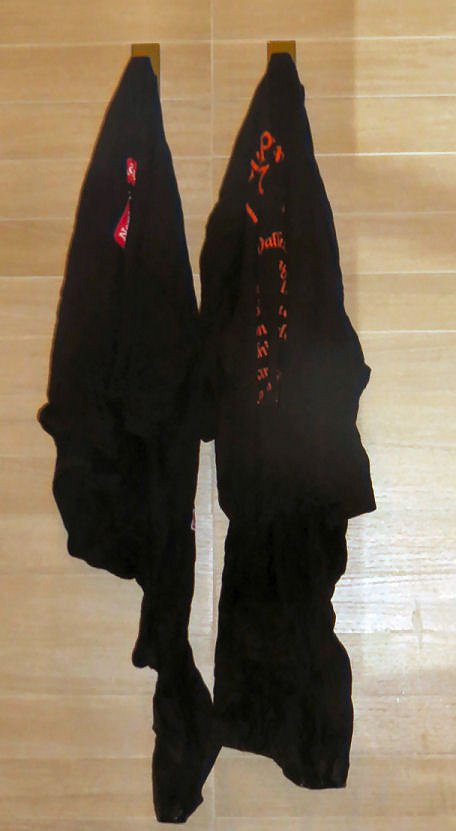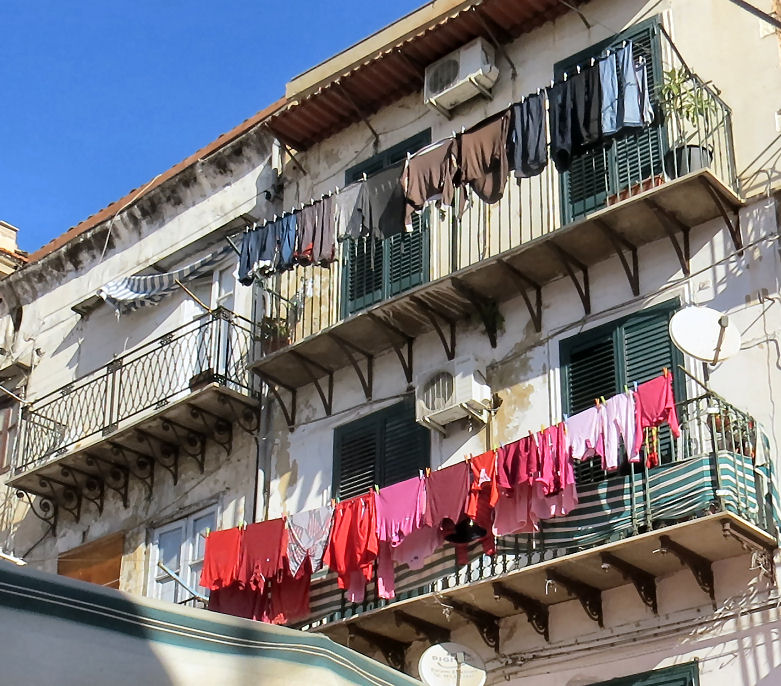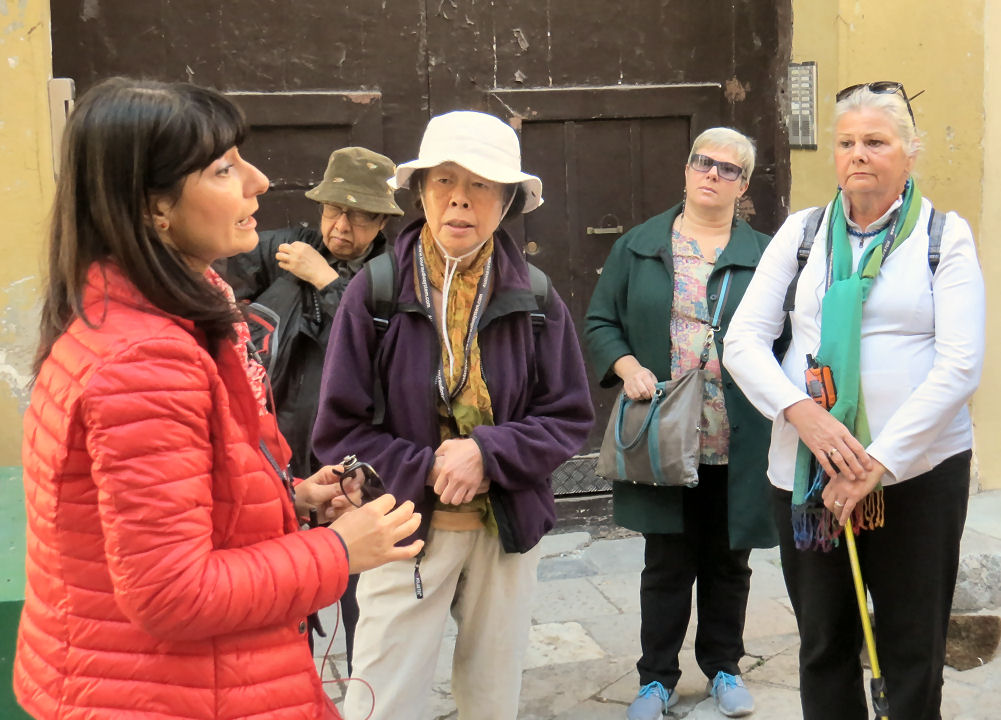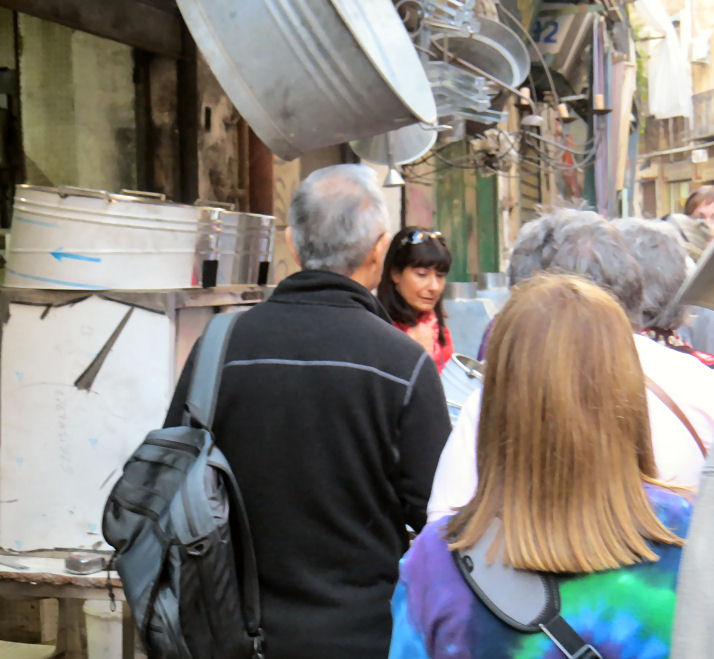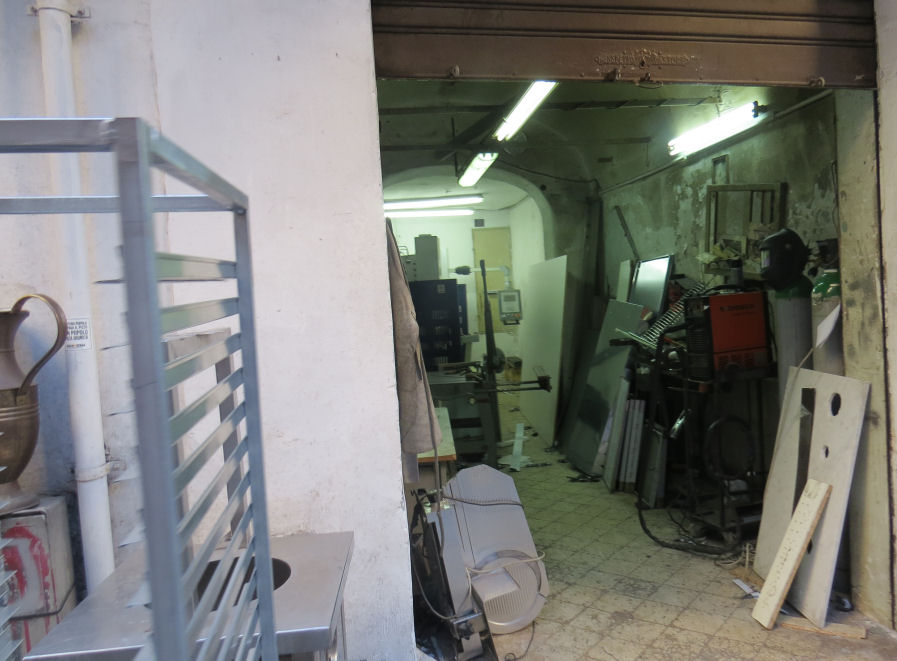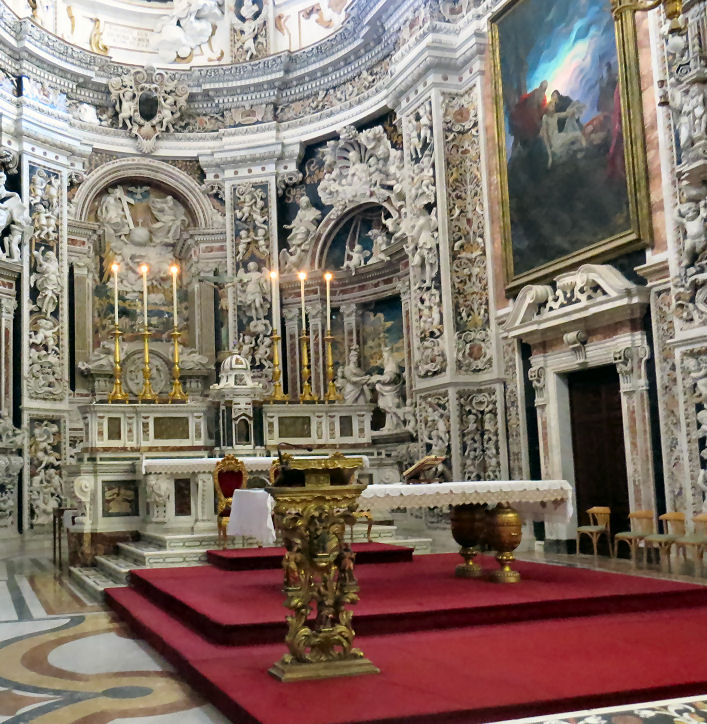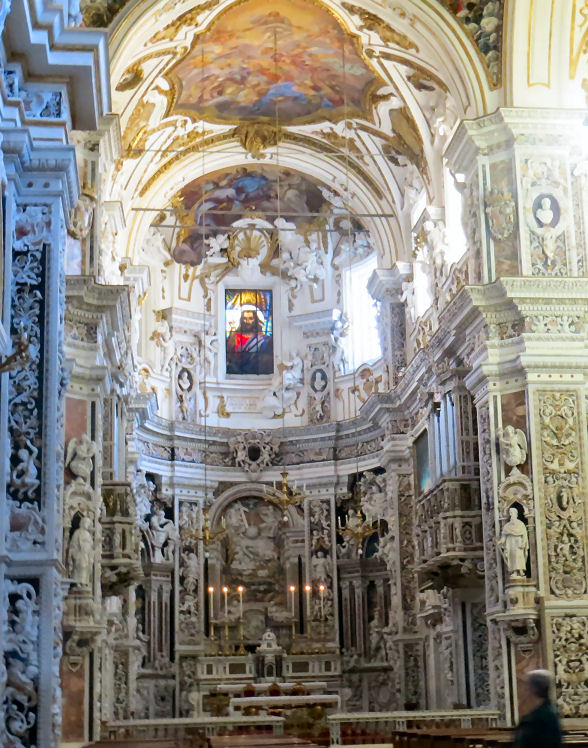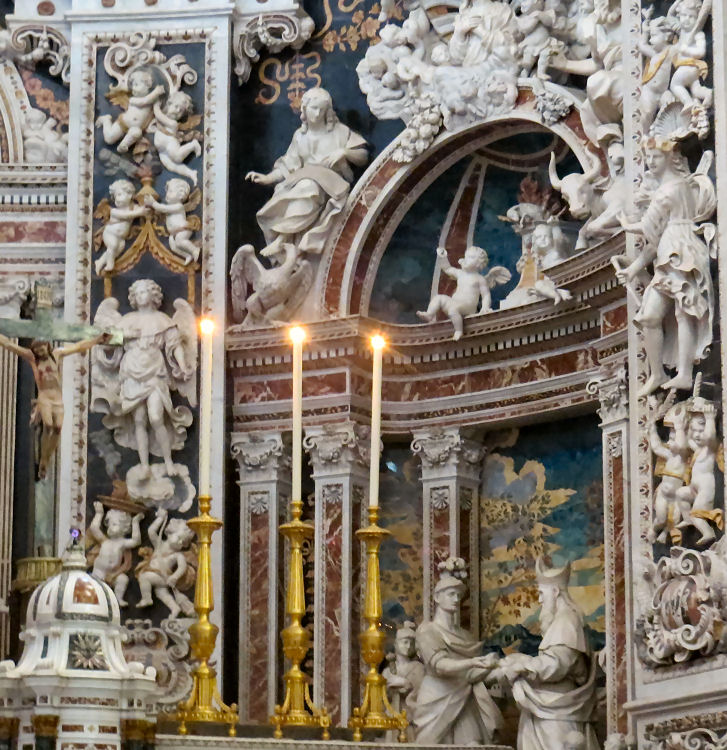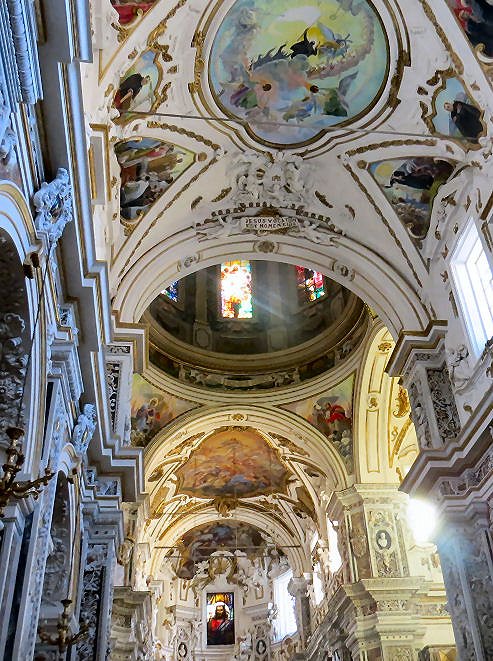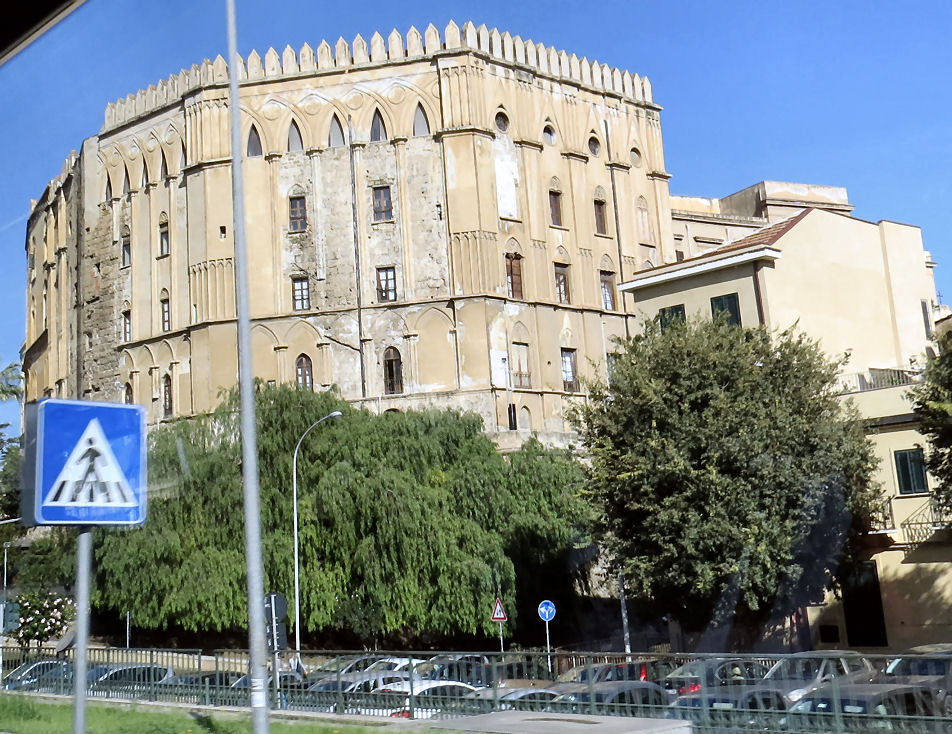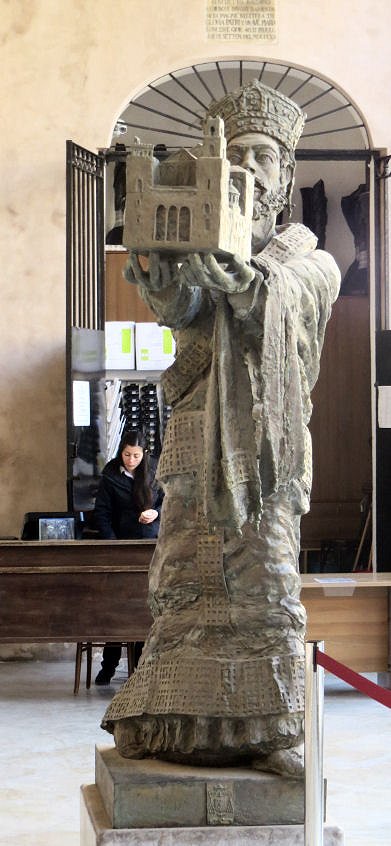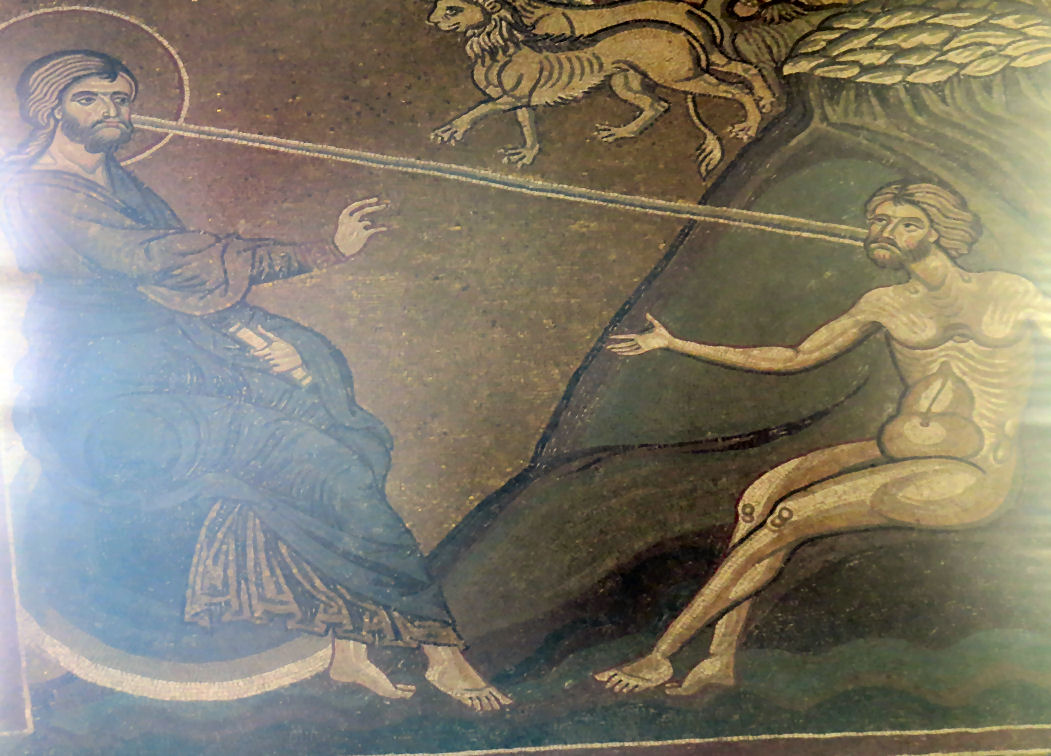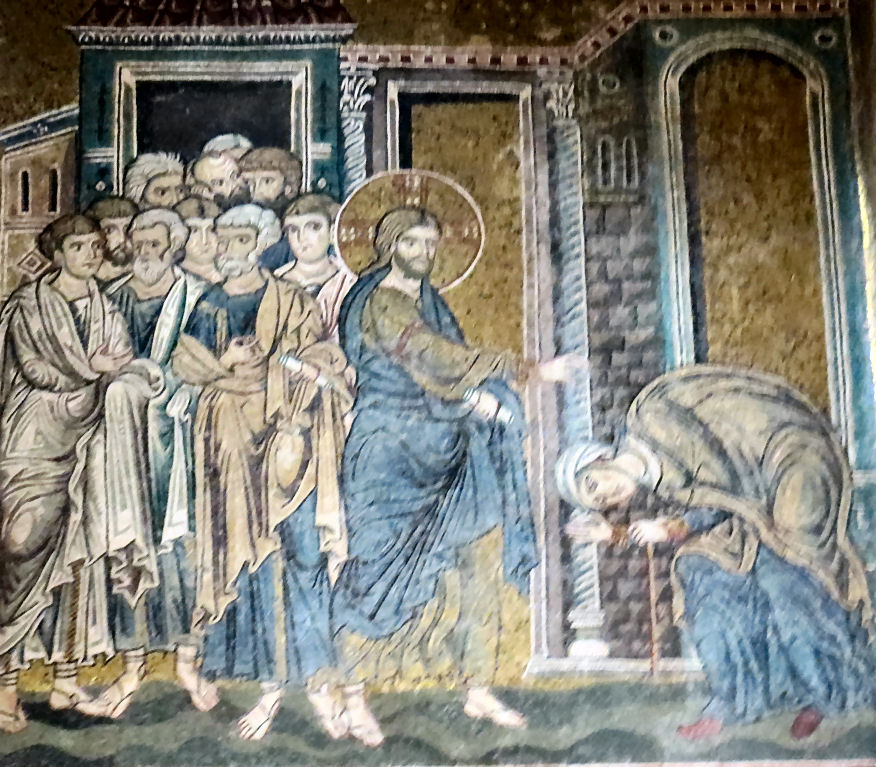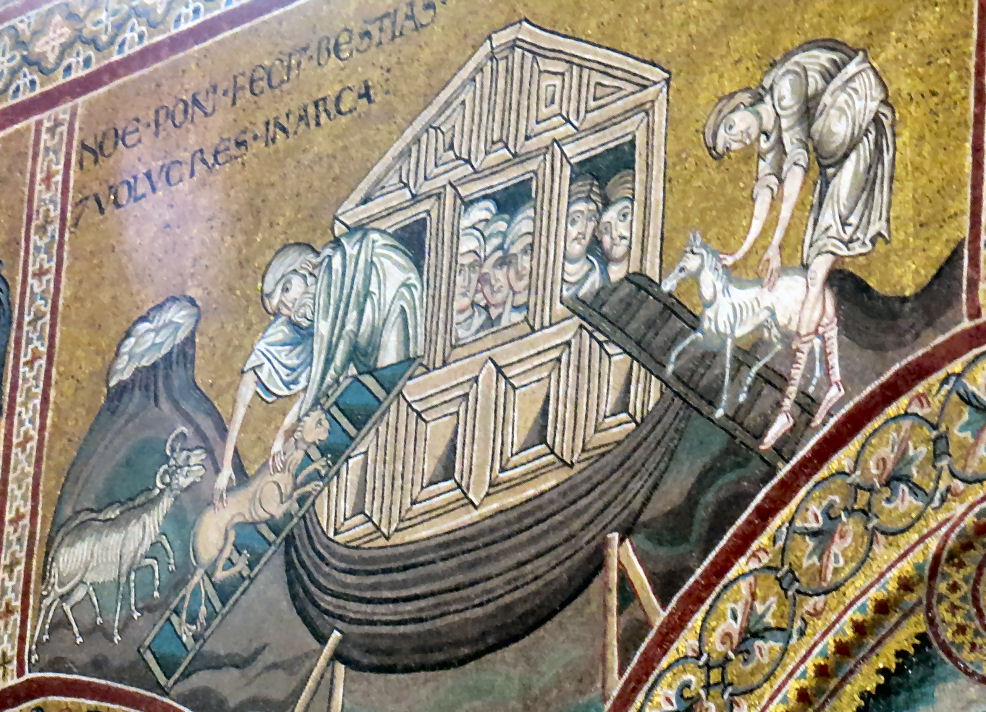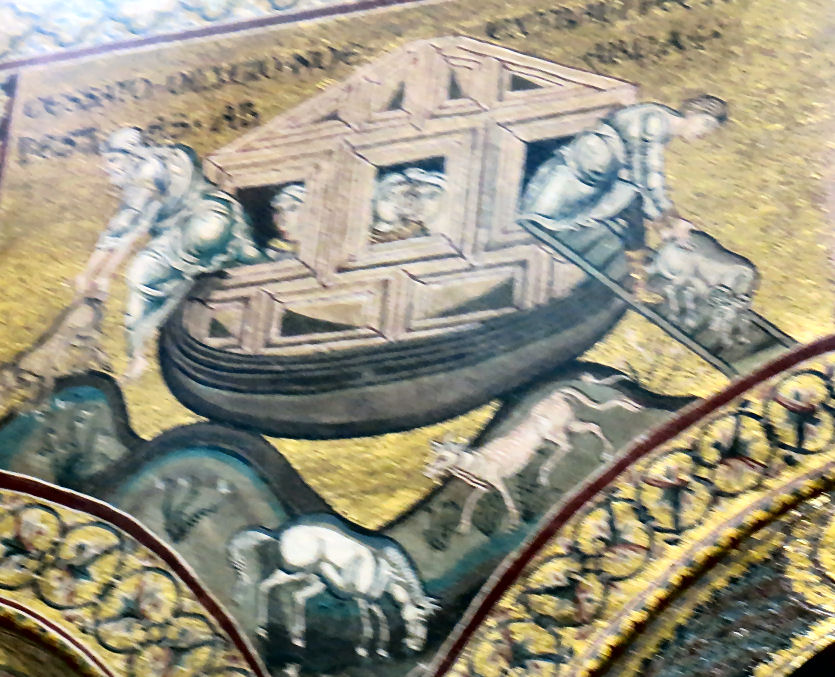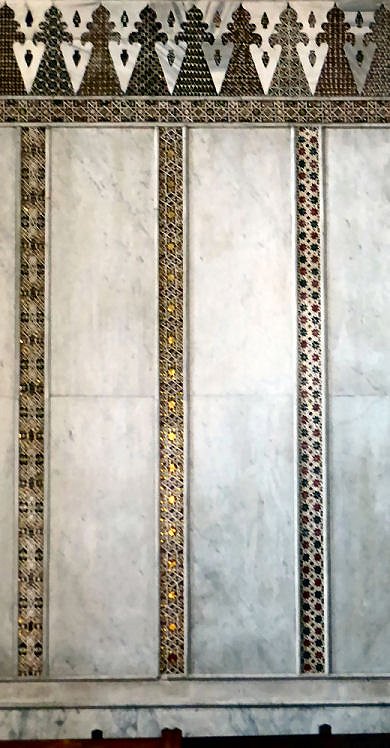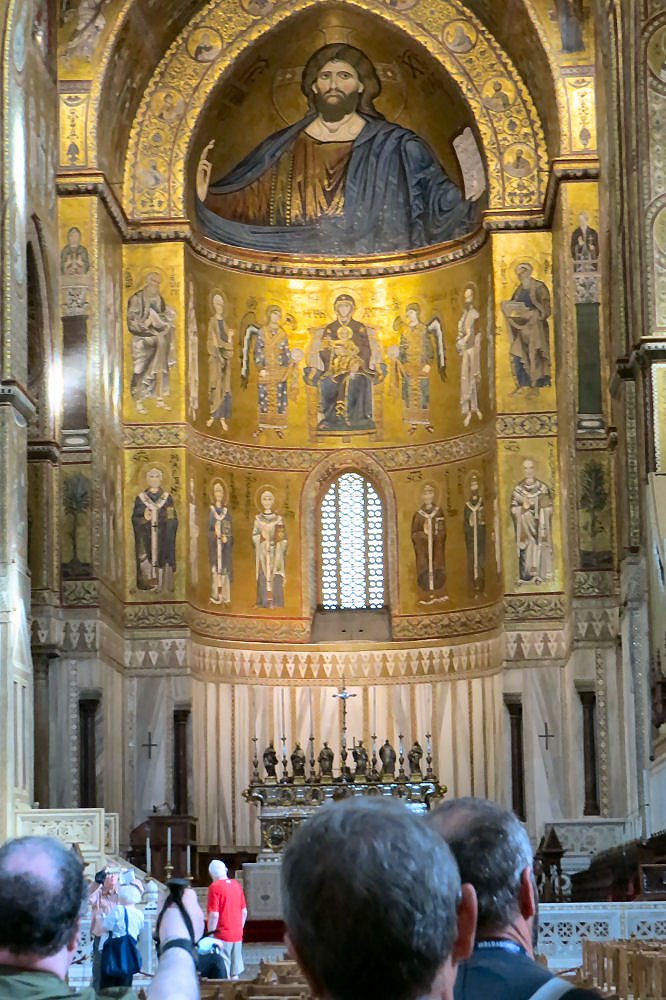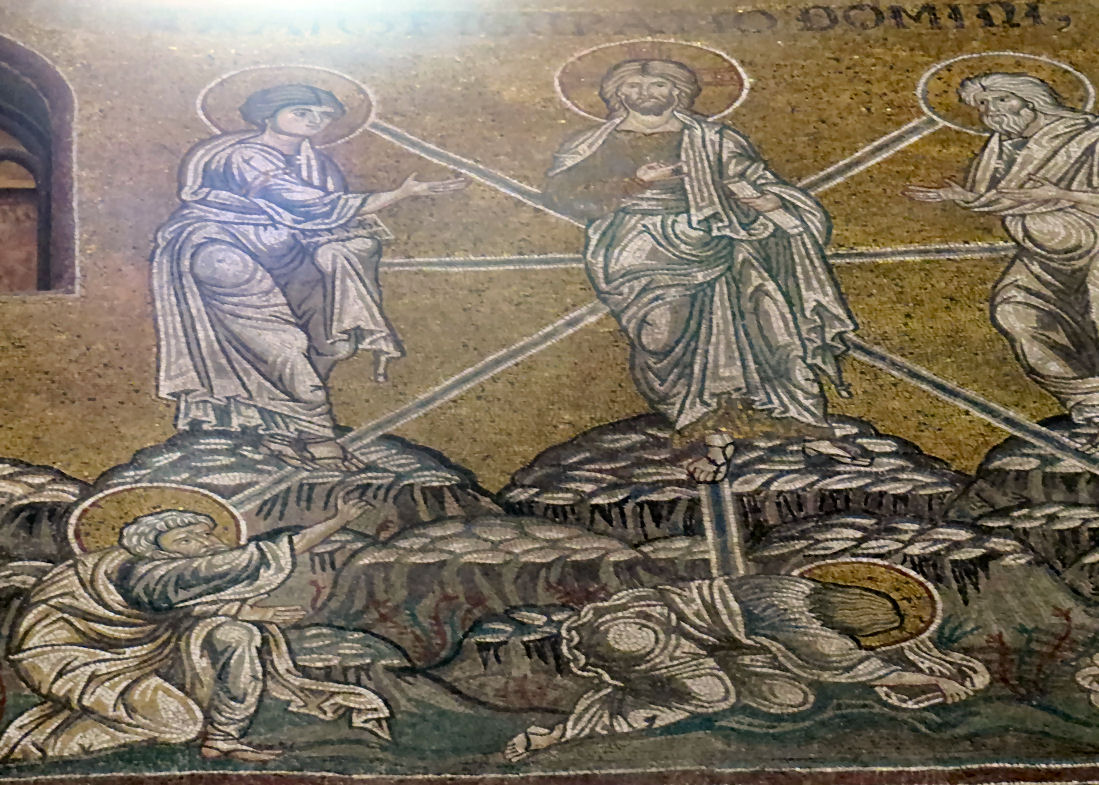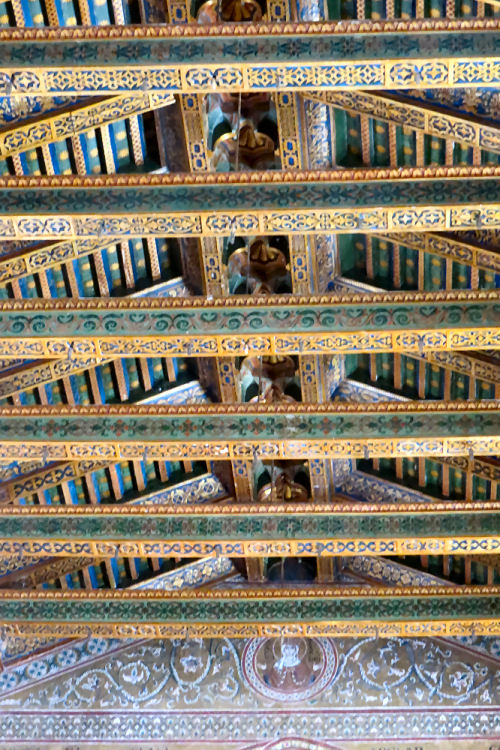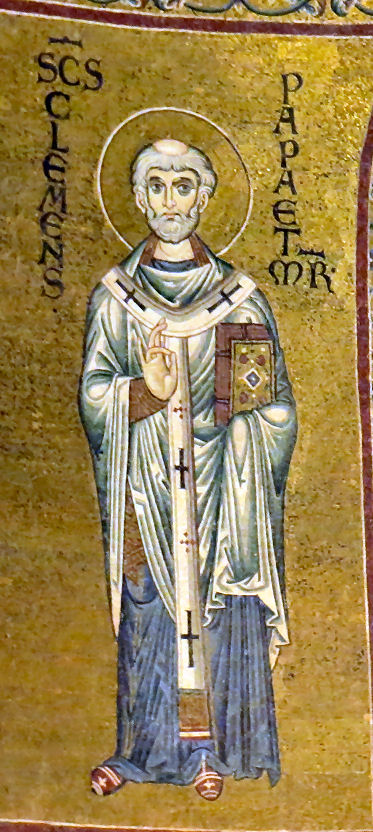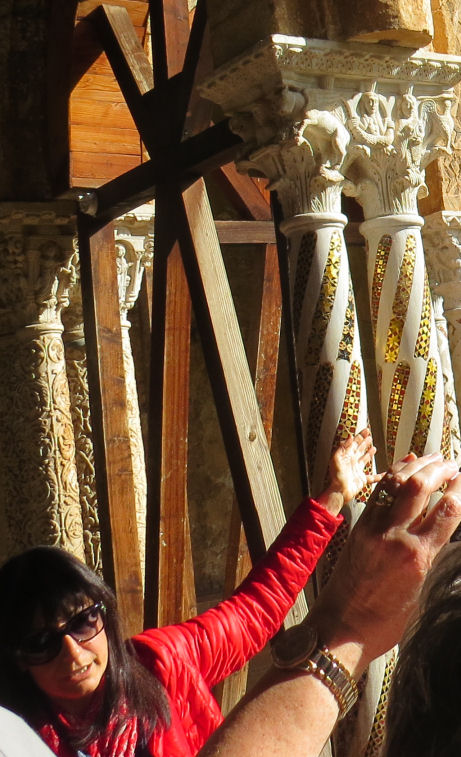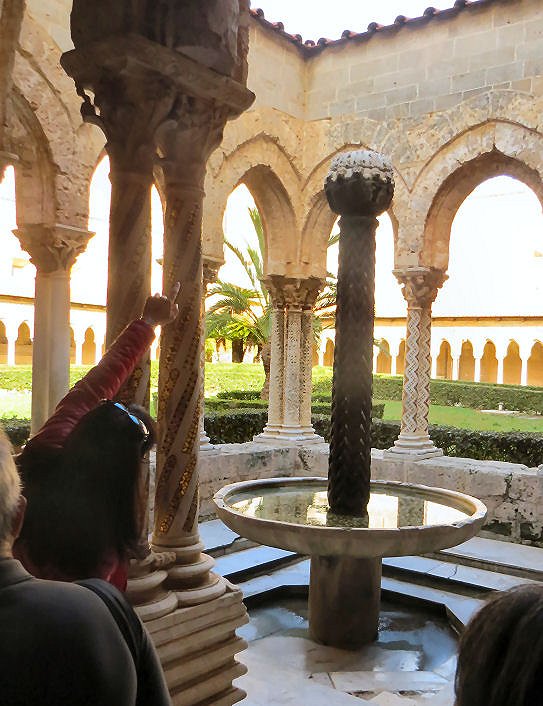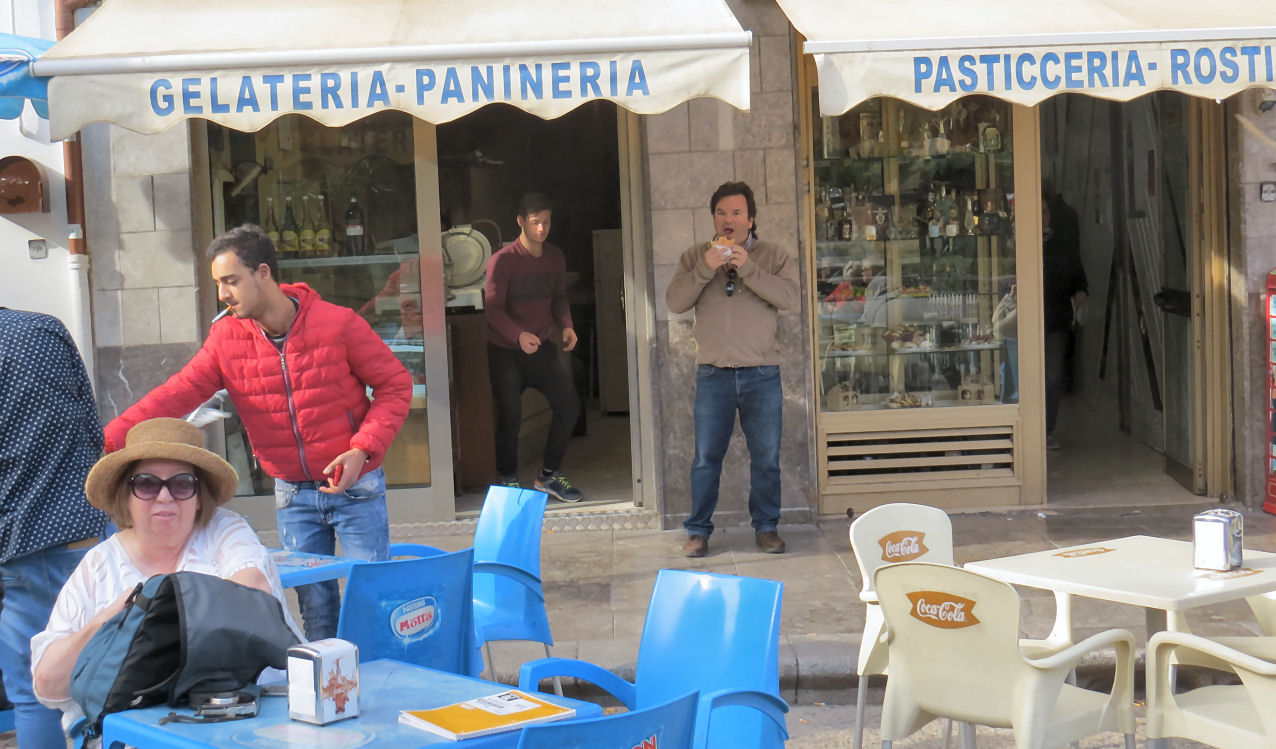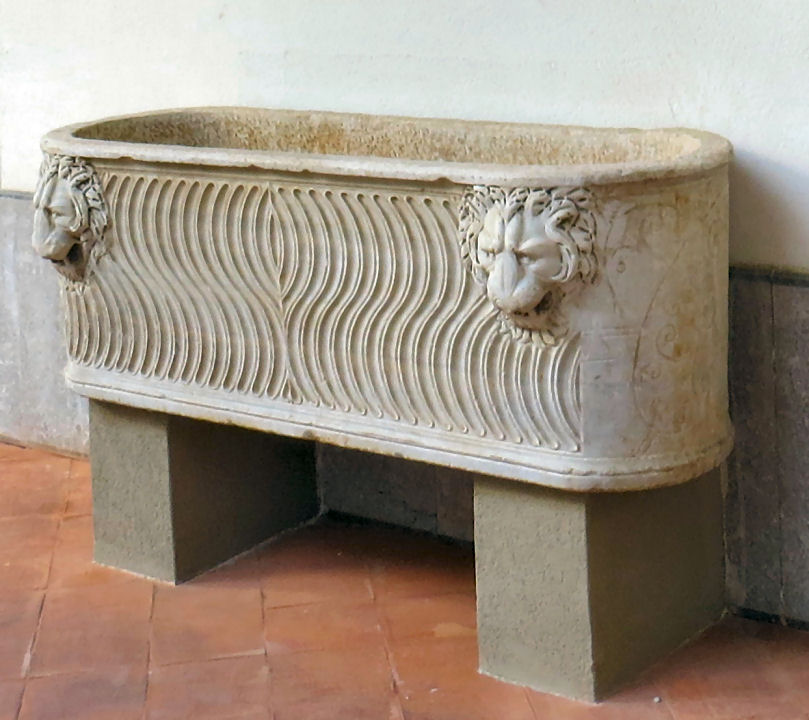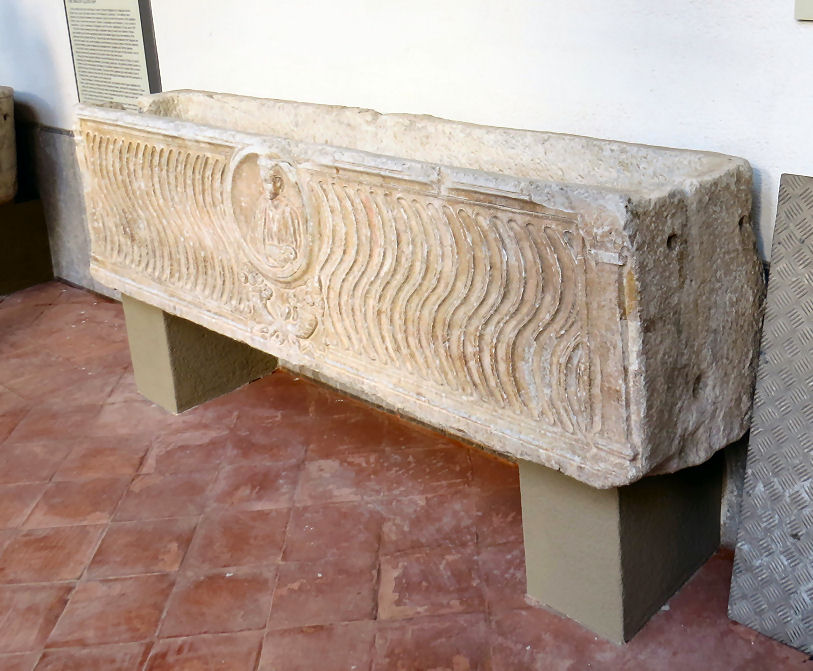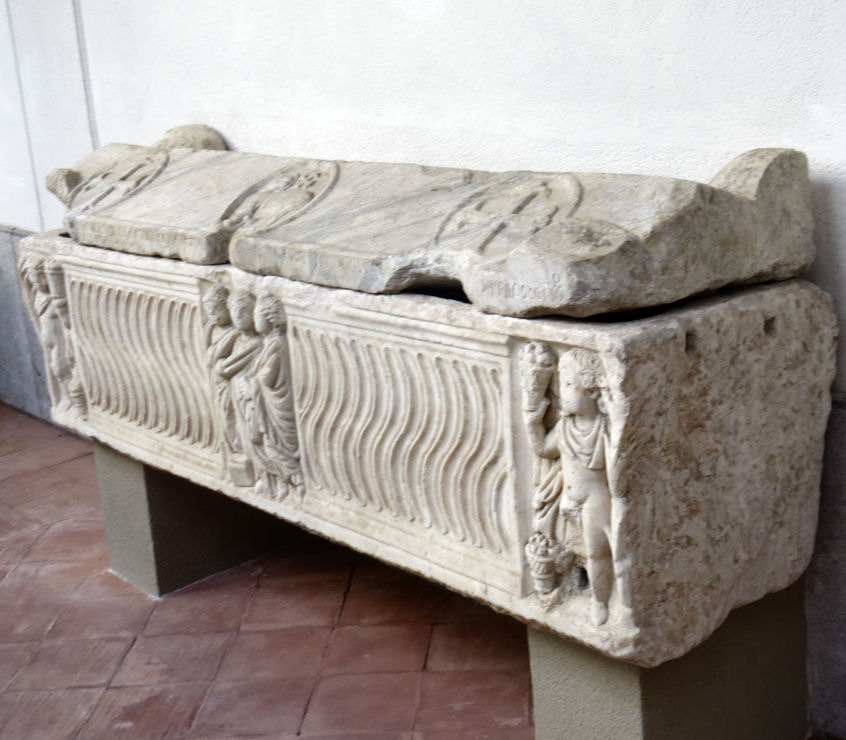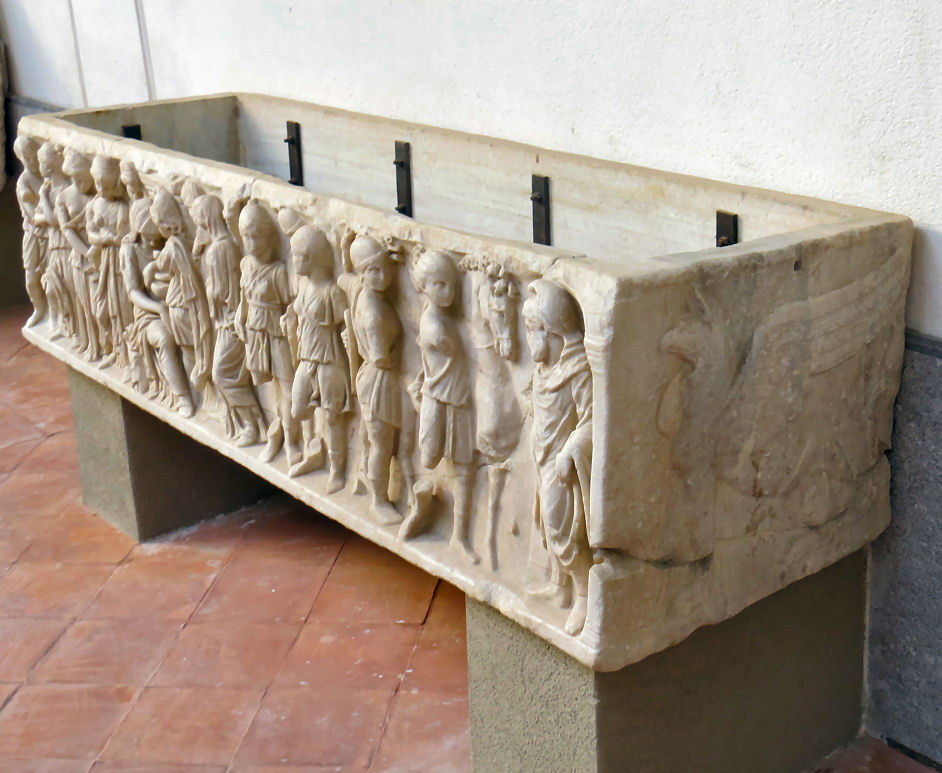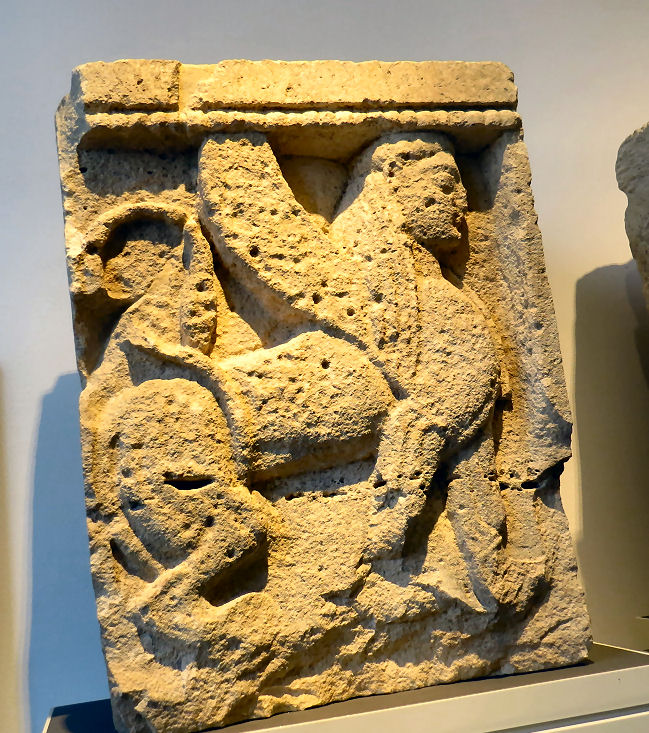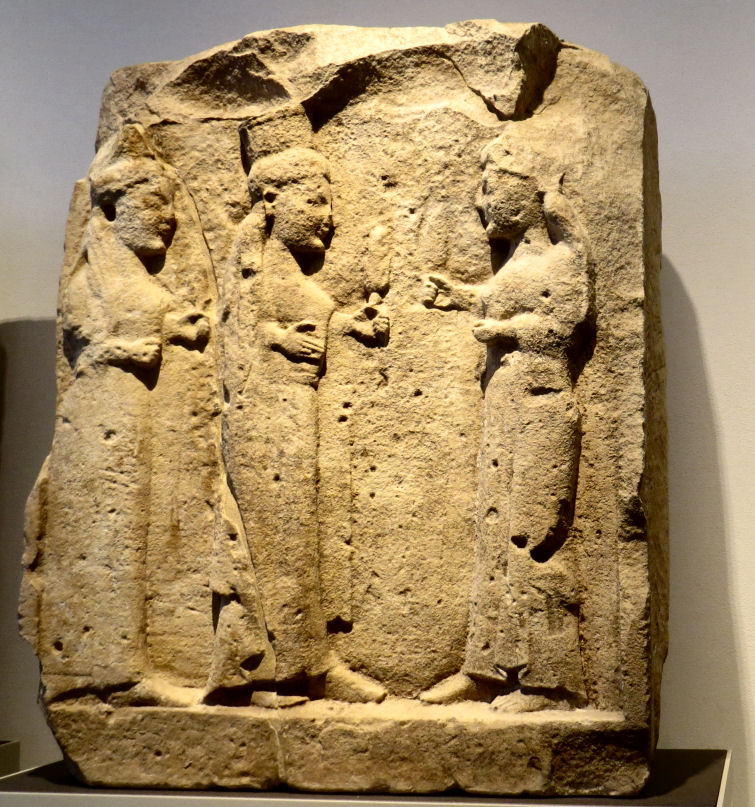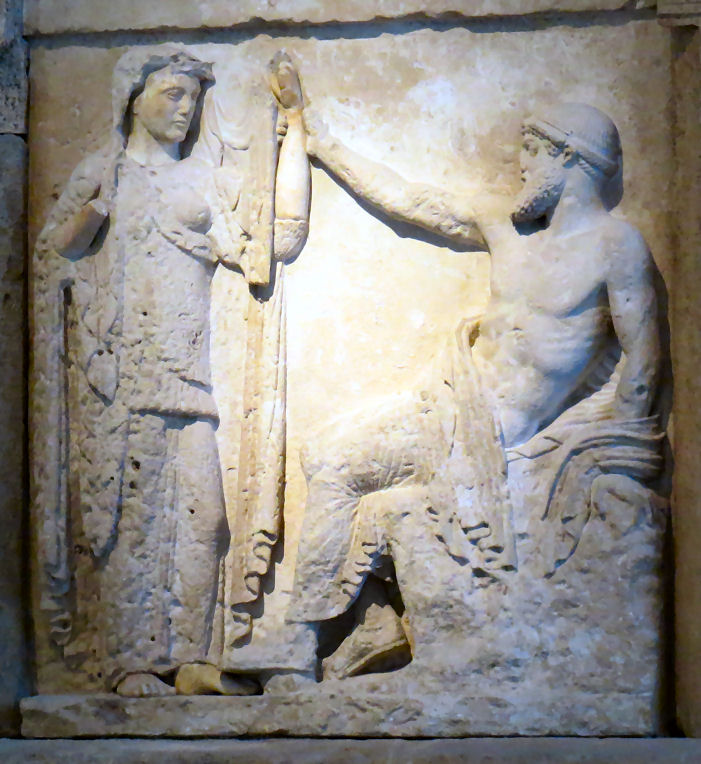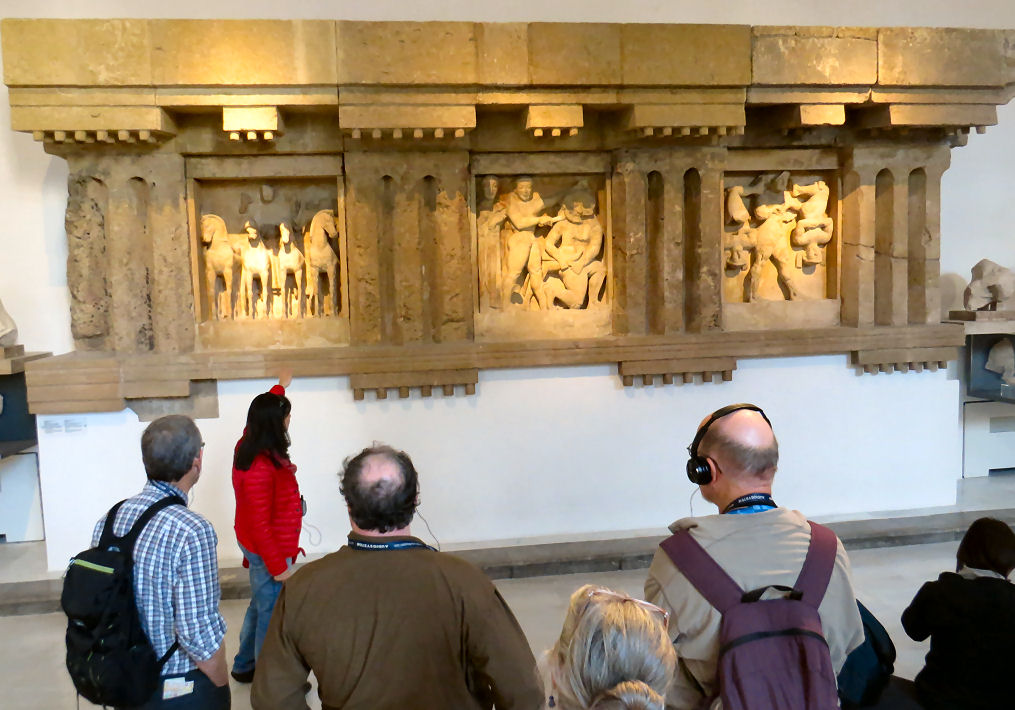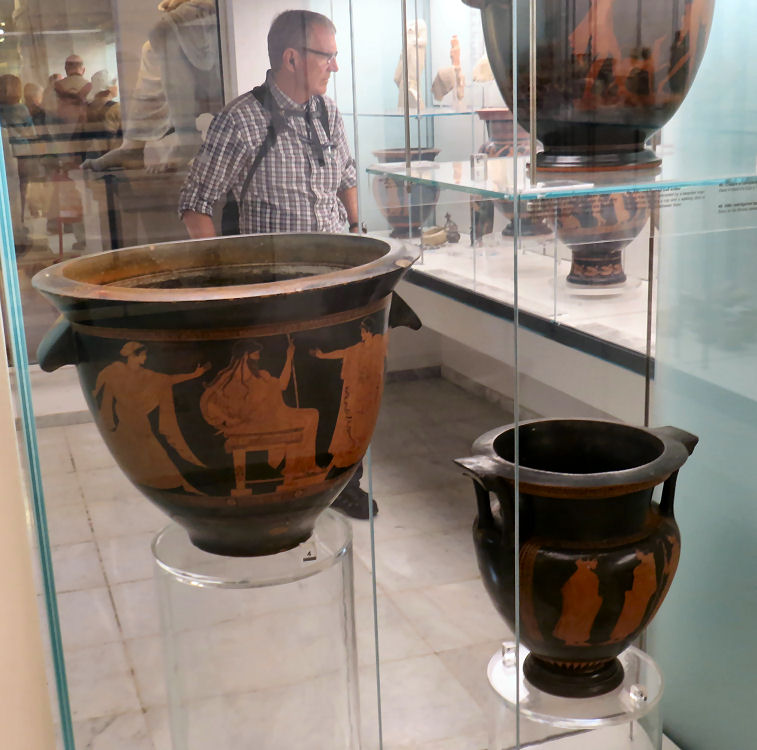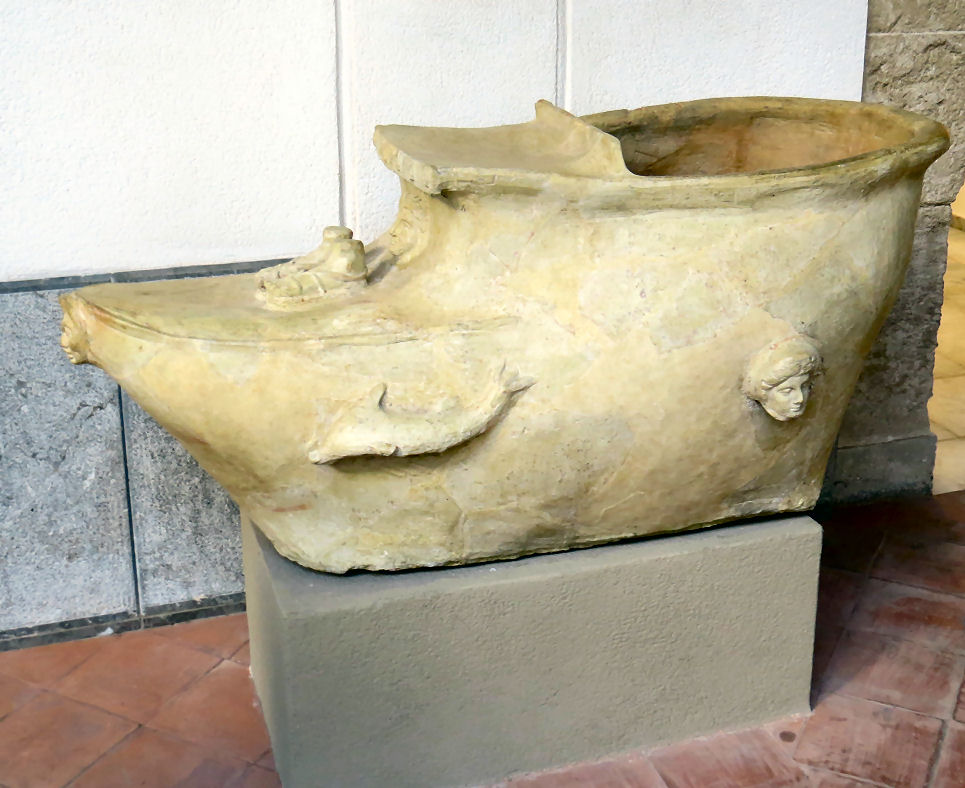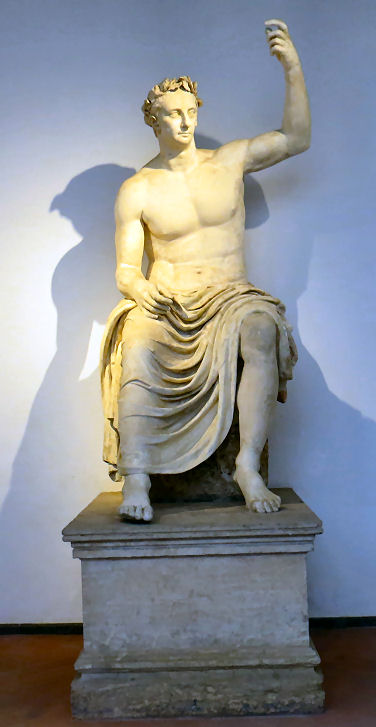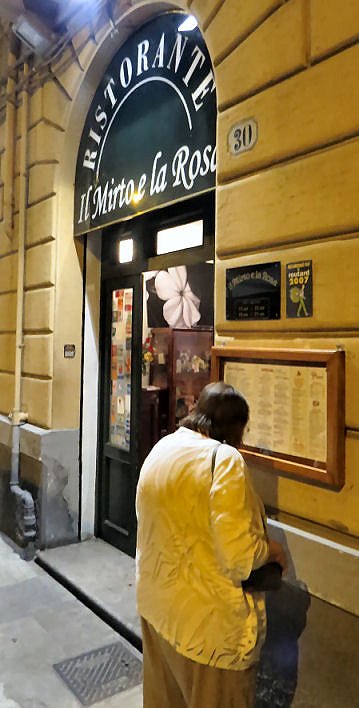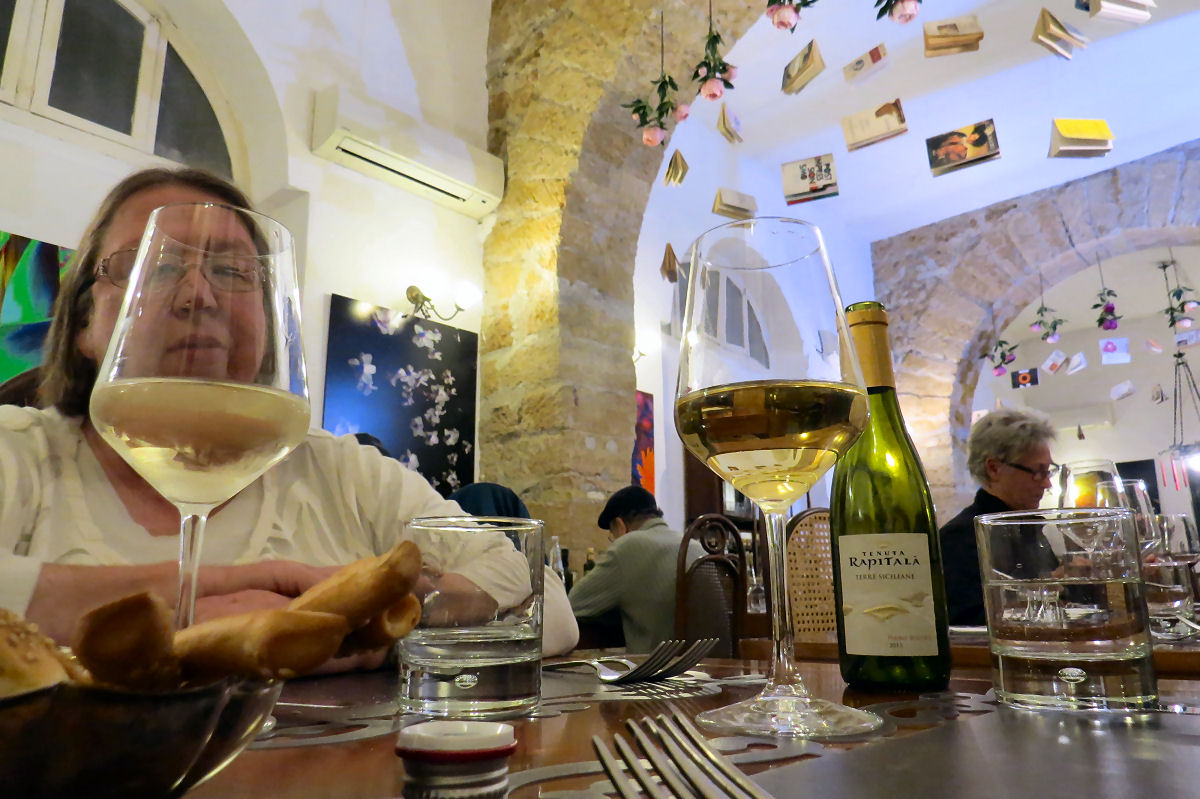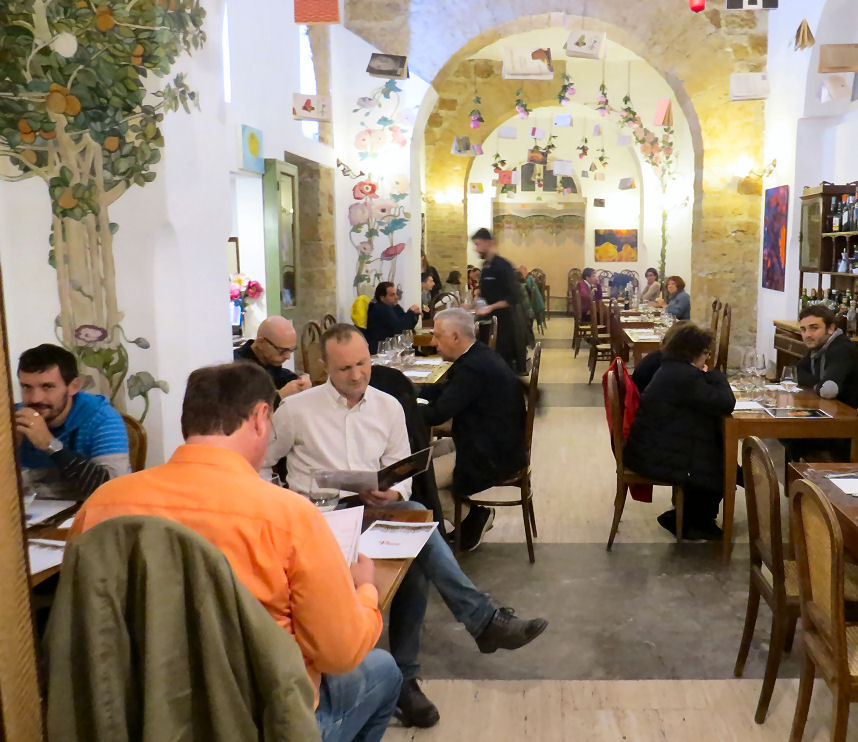Something very strange happened during the night. Three or four times there was a loud crack that came from the direction of the door. It sounded like a large piece of wood that was being split. It was somewhat unnerving.
I felt better when I woke up, but I was still coughing and sneezing occasionally. I was not sick; I probably had just contracted a cold or something on one of the flights. I heard one more crack, and then I arose from the bed and washed out two pairs of socks and underwear as well as two tee shirts.
Our first full day of the tour began at the breakfast room on the seventh floor. Sue did not insist on taking the stairs this time. The buffet featured scrambled eggs and the usual assortment of bread, cheese, salami, and brioches. I was able to find enough to satisfy my stomach.
If any napkins were available, I did not see them. One of my pet peeves about traveling in Europe was that it was often very difficult to find sufficient disposable paper products. Tissues were worthless to me; my sneezes and nose-blowing had been measured using the Saffir-Simpson Hurricane Wind Scale.
Our guide Jackie told us that she grew up in California, but she came to live in Sicily because it was the land of her ancestors, and she wanted to do whatever she could to help those who lived there. I, for one, believed her; from what she told us of her work with refugees, she definitely seemed to “walk the walk.”
Throughout the day Jackie delivered a very large quantity of information that was a mixture of facts and analysis. I could keep up pretty well, at least until the end of the day, but I was beginning to wonder if one spiral notebook would be enough to hold my notes for this trip.
Jackie told us about the Berber Jews, natives of Tunisia who comprised 10 percent of Sicily's population and 7% of Italy population in the 15th century. About 20-30 percent of them converted to Christianity when they were faced with the expulsion edict issued by the Spanish Inquisition in 1493.
We visited Via Calderai where local craftsman have made hand-hammered pots for years. It seemed incredible that they could still be engaged in this activity, but we saw plenty of pots, pizza racks, and strangely tilted pans that were used for offal.
I wrote down that 1997 was the one-thousand-year anniversary of cassata. If so, then it must have been invented during the long period of Arab domination of Sicily.
Palermo was settled by the Phoenicians in approximately 750 BC. The name of the city for many centuries was Panormous. As we saw on the map on the floor of the palazzo the previous evening, two rivers formerly ran through the historic center of Palermo. At that time the harbor was probably worthy of the name, which means “all ports.” The monumental engineering project of eliminating those rivers from the center of the city was undertaken by the Arab rulers in 969.[1] At that time the Fatimid clan, based in Cairo, was ruling Sicily. The Persian water engineers whom they hired devised a scheme to divert both rivers in order to irrigate the crops. In the tenth century at least 100,000 people lived in Palermo, which made it the second-largest settlement in Italy.[2]
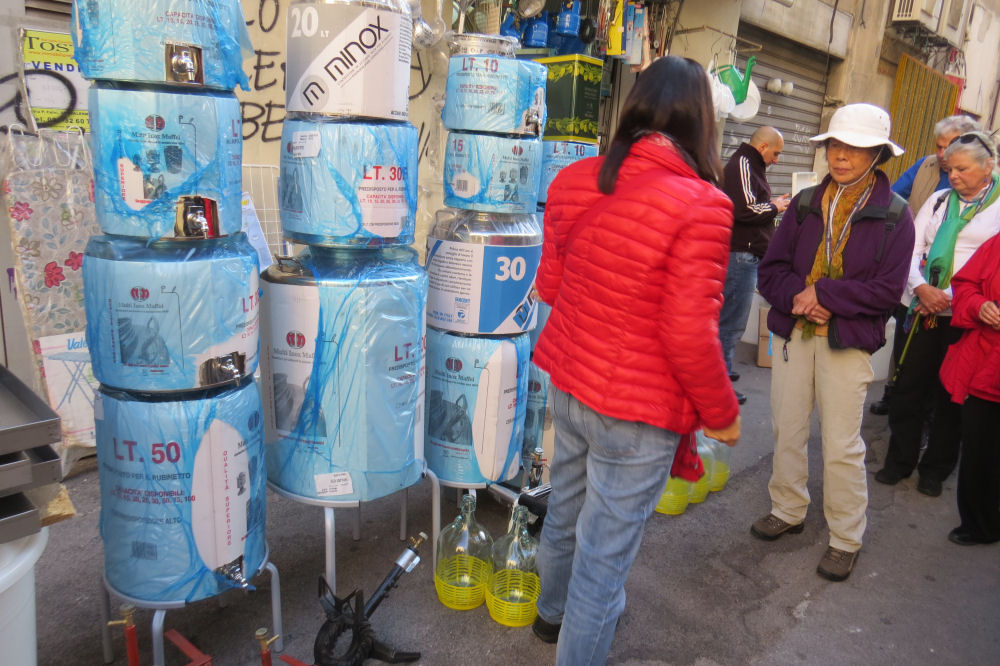
Just before our visit to the Church of the Gesù, Jackie explained that much of Sicily had been destroyed by bombs (yes, American bombs) during World War II. A bomb landed in the church, but it did not explode.[3] I could vividly remember that a similar story was recanted to us—with vivid physical evidence—on our visit to Naples in 2011. That was also a Jesuit church! By the summer of 1943 the entire island was liberated by the Americans and English.
Marble was not used much in Sicilian churches. Jackie called what they used instead “near-mable” or “marmi mischi”. The blue variety came from Brazil.
The Church of the Gesù was established by the religious order called the Society of Jesus, better known as the Jesuits. The order was banned from 1759 through 1820. This was not just a Sicilian or even a Spanish phenomenon. The popes were intimately involved in this complex and strange story. You can read my take on this period here.
After our visit to the Jesuit church, Jackie shone the spotlight on the Normans, who wrested Sicily from Arab control in the twelfth century after a protracted struggle. Jackie insisted that the Normans[4] had come overland to Italy and “the pope”[5] had granted them free rein in Southern Italy to spread Roman Catholicism. King Roger II established Palermo as his capital. Norman influence was still felt in the twenty-first century. Jackie reported that 4 percent of Sicilians have the gene for red hair.
Jackie emphasized that Sicily had benefited greatly from the Marshall Plan.
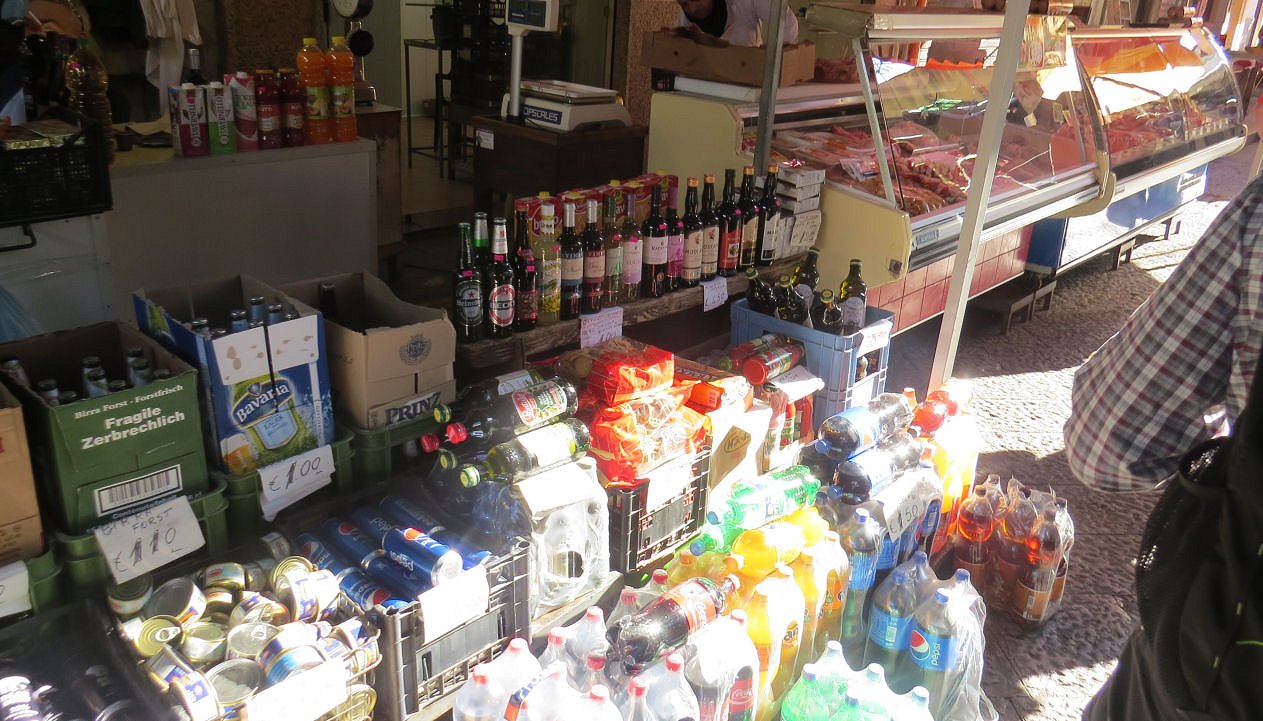
In 1013 a combined force of Byzantines and Normans attempted to retake Sicily. They achieved some limited success, but eventually they gave up. The Great Schism in 1054 put an end to the cooperation between Constantinople and the Byzantines. By the third decade of the eleventh century the Normans had prevailed over the Arabs. On Christmas day 1130 Roger II was crowned King of Sicily,[6] which by that time meant the island plus southern Italy. The kingdom remained more or less intact until the Risorgimento of the 1860's.

Roger was followed by William I and then William II. The latter died without any heirs, which led to a leadership crisis on the island. A long period of unrest was never really settled until the time of Frederick II at the end of the twelfth century.

At that point in the story our group had reached the Ballarò street market, a huge but nevertheless very crowded area that featured people coming from all directions and fishmongers screaming at the top of their voices. I must admit that I have seldom felt so uncomfortable. In fact, if more of the people present had been smoking cigarettes, I would have thought that I had died and been condemned to my own special hell.
Jackie gave us a break to spend some time shopping if we wanted. Sue decided to look for an electrical converter. It would never have occurred to me that we might find one in this madhouse, but she succeeded. I located myself in a sunny spot where I would not be jostled by dozens of strangers and took photos.
Giuseppe, our bus driver, was scheduled to meet us at 11:30, but he did not arrive until twenty minutes after that time. We all piled onto his pullman for the short drive to Monreale.
Jackie pointed out some Chinaberry trees along the side of the road. She said that the berries from these trees were used as beads in rosaries. As we passed them she also identified the much smaller market in which she purchased her fruits and vegetables and her fishmonger's stand. Since she was a steady customer they gave her good deals.
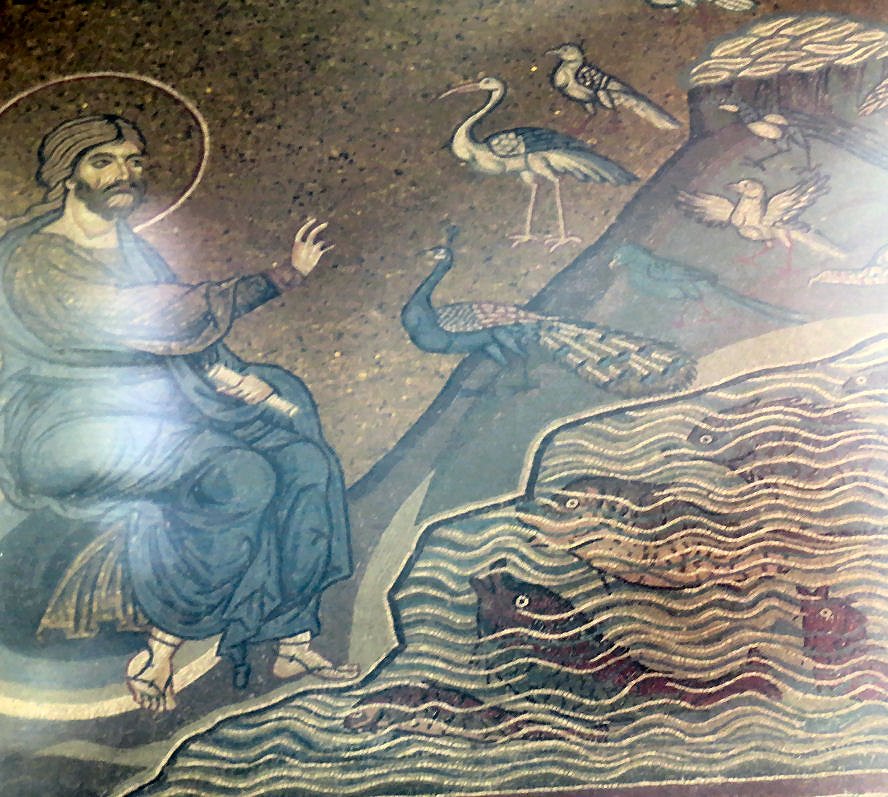
She then resumed her story of the Norman era, which she described as the Golden Age of Sicily. She said that the Archbishop of Palermo tore down the Norman cathedral there and built a new one.[7] At the time the Norman kings had the “right of investiture”[8] of bishops in Sicily as decreed by Pope Urban II. William II was therefore steamed that his “creature” had gone against his wishes. He decided to build a cathedral of his own near his hunting lodge in what was now called Monreale. That was the one that our group would be visiting. Pope Lucius III made William's wish into church law when he issued a bull that declared Monreale, as a “metropolitan,” despite the fact that it was only a stone's throw from Palermo, which was also a metropolitan. Monreale no longer has that designation.
The Palermo Valley is called “La Conca d'Oro,” which means the Golden Bowl.
The cathedral in Monreale has many mosaics. Jackie said that the art of making and repairing mosaics was taught in high schools in the area. It astounded me to learn that there could be enough demand for this activity to justify this. Who knows? In a land where they still hand-hammer pots, the mosaic repairman may well be a valued artisan.
The cathedral's most famous and most outstanding mosaic is the Christ Pantocrator,[9] which is 38 feet wide and 22 feet high. Jackie said that the windows in the cathedral reflected the Fatimid Arab influence. The arches were pointed, as in most Norman buildings.
My notes indicated that a fire caused by lightning in 1861 necessitated the replacing of figurines. I could find no mention of this on the Internet. I probably misunderstood or wrote down the wrong thing.
Jackie explained that the eight-pointed star that was prevalent in the cathedral is actually an Islamic symbol. Some of the builders hired by William were Arabs.
She also explained that the mastics used in the mosaics were finely powdered marble or travertine. In some cases pieces of glass were added.
The cathedral was never bombed during World War II. In the Palermo area this was quite a distinction.
The organ in the church boasted eleven thousand pipes. The cathedral also housed the porphyry tomb of William I and the white Carrara marble sarcophagus of William II. The side door of the Cathedral was made in Pisa.
The cathedral also contained a mosaic that portrayed an imaginary meeting between Jesus and William II. William appeared to be a little smaller in this work, but he made sure that his throne in the church was higher than the archbishop's.
After some time to explore the cathedral the group repaired to the Benedictine cloister. Its 228 columns were fairly fragile. Most were decorated with spirals of Islamic symbols. Many were in the process of being repaired while we were there.
The fountain was supposed to represent the junction of four rivers, but for practical reasons it was moved to a corner. I wrote down “lava stone from Vesuvius,” but I do not remember what the phrase referred to.
We were on our own for lunch in Monreale. The weather was quite nice, at least in the sun, and so Sue and I decided on a place called Bistro, which had plenty of outdoor seating. It advertised itself as a Gelateria, Pasticceria, Panineria, and a Rosticceria. Essentially they claimed to serve everything. Indeed, the menu had eight or ten laminated pages of tasty-looking items. Unfortunately the first few items that I asked for were “finished.” I ended up with a “Diavolino,” which was a panino with spicy cold cuts, eggplant, and cheese. It was OK, and the Coke Zero hit the spot. Sue had a crepe that looked like a taco and white wine. When she asked for a gelato at the end, they directed her to another store that sold something that they called gelato out of a small freezer. Some gelateria.
Sue then went shopping. I sat in the sun, read my book, and watched people. I saw a very cute dog that appeared to be a combination of dachshund and Scottie. I tried to snap a photo, but I was not quick enough.

Sue was very late getting back from lunch. All the rest of us had trooped down to the bus, but Susanna stayed behind to look for Sue. Jackie communicated with Susanna by cell phone and grilled me about Sue's habits, but I pleaded the fifth. Sue finally showed up about twenty minutes late with a package of tiles that she had purchased. Susanna did not seem to be angry, but I knew from experience that tour guides for Rick Steves considered it extremely important to keep to the schedule.
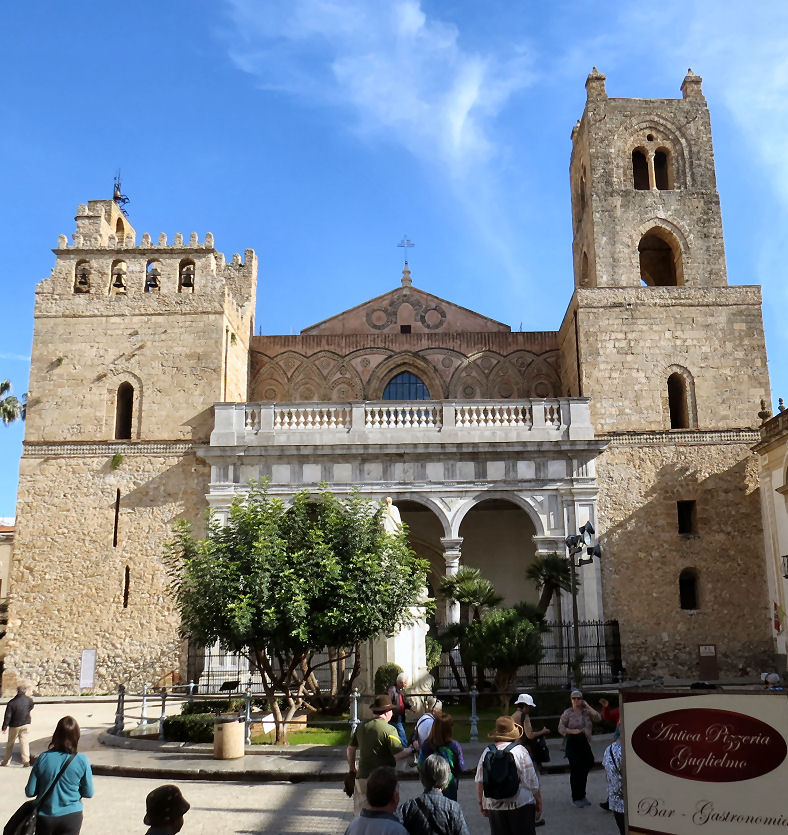
Giuseppe, our red-headed bus driver from Taormina, drove us back down to Palermo. Our destination was the Archaeological Museum. The full title is Museo Archaeologico Regionale Antonio Salinas.
On the way Jackie informed us that her publisher[10] was very picky about her being recorded. She said that she specifically did not give permission to anyone in the group to use any recordings of her talks, either audio or video.
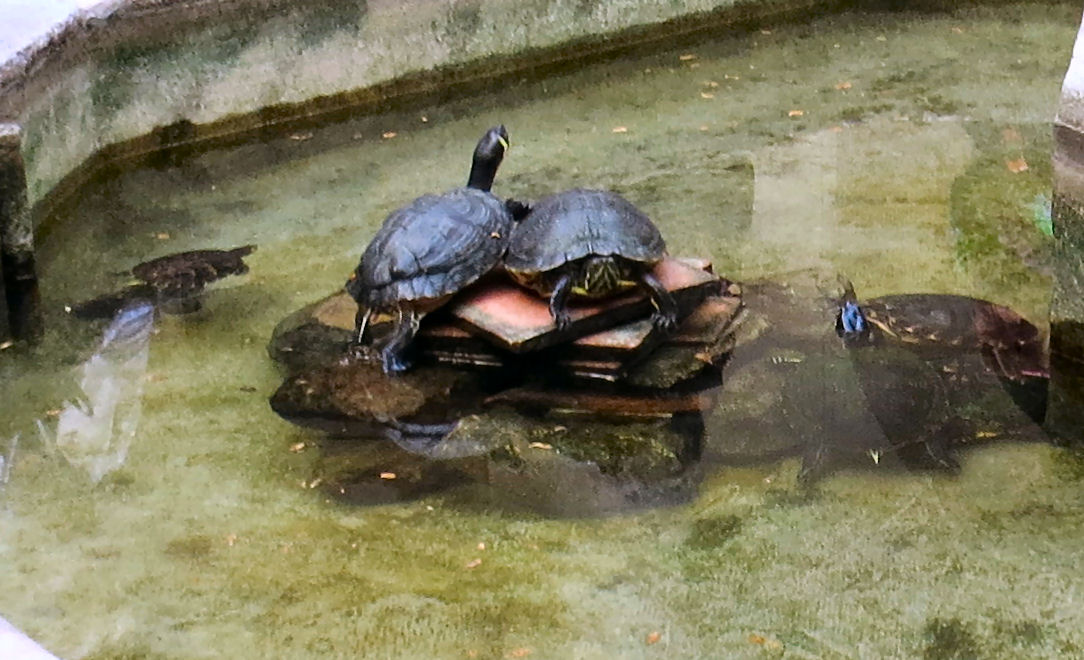
Jackie resumed her tale of the demise of the Norman rule after the death of William II. The explanation of who was related to whom was pretty difficult to follow. The ruling families constantly intermarried, and so a fairly large number of people had tenuous claims to the crown. Eventually Frederick II was able to take the throne. He was crowned King of Sicily at the age of three. His line was through his mother, Constance of Hauteville, who was the daughter of King Roger II.
The items on exhibit in the Archaeological Museum constituted a small portion of the huge personal collection of Antonino Salinas, an archaeologist who directed the museum from 1873 until his death in 1914, as augmented by some later donations and acquisitions. Salinas participated in the digs at Mozia, Tindari, and Selinunte. He also somehow came by a large collection of Etruscan artifacts.
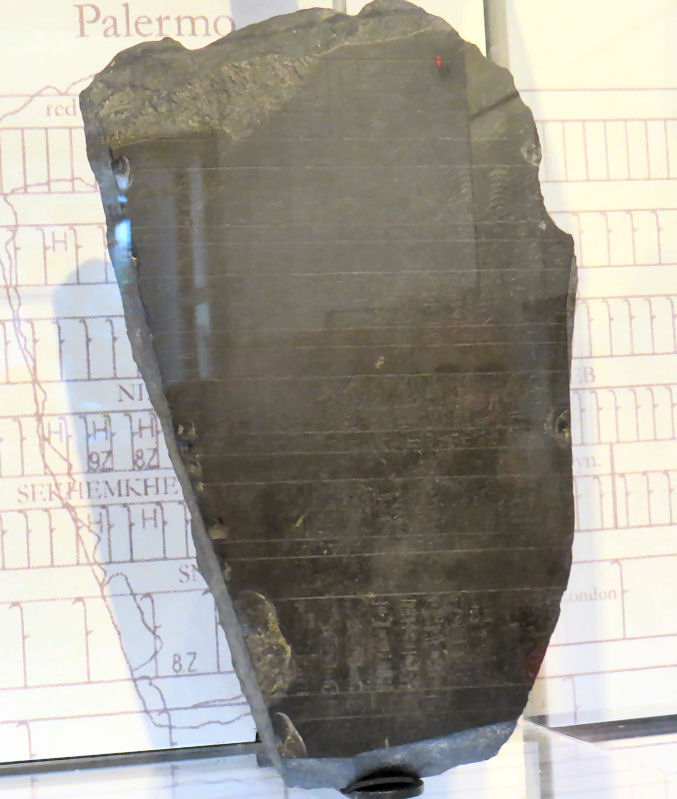
The most famous item in the museum, the Palermo Stone, was donated to the Archaeological Museum in 1877. It is a portion of a large stone stele that at some point was broken. Other fragments are now in London and Cairo. The stele contained a hieroglyphic list of the rulers of Egypt and summaries of important events in each reign.
The museum contained a model of a very large Greek city on the southwestern coast of Sicily called Selinunte. Evidently approximately 200,000 people lived there in the fifth century BC. Eleven temples have so far been discovered in the archaeological digs.
The city had a long rivalry with Segesta. Eventually the Carthaginians got involved and captured the city a number of times. Before the end of the First Punic War the Carthaginians abandoned Selinunte and destroyed it. This occurred in approximately 250 BC.

Although what was left of the Greek temples appeared quite drab in the twenty-first century, they were painted in bright colors back in the day.
For some reason Jackie showed her tour guide ID to one of the other tour members. It showed her (middle?) name as Calogera. St. Calogero is the patron saint of Naro, which is the origin of a small colony of Sicilian families who have settled in our home town of Enfield, CT.
I did a poor job of taking notes. A few phrases appear in my notebook about what some of the many artifacts depicted, but I did not note where they were discovered. Part of the problem was that it was difficult, at least for me, to figure out the pattern of the way things were laid out in the museum. On the other hand Jackie definitely understood it, her explanations were vivid, and at the time I thought that I had a feel for what was what.[11]
When the tour of the Archaeological Museum had ended, Jackie said good-bye to us, and Susanna explained quickly how to get back to the hotel. She also gave a brief description of the location of some of the other attractions in Palermo's historic center.
While Sue used the ladies' room, I sat on a bench near the museum's exit. I felt exhausted, and I had no interest in anything except resting. I was accustomed to walking as much as eight miles with no breaks, but on this trip I found standing around in museums very draining. Sue was likewise ready to head back to the hotel.[12]
Although it was farther away than we thought, we found our way back to the hotel with minimal difficulty. I slept from 4:30 to 7, and when I awoke I still felt tired and a little feverish. I took a couple of acetaminophen tablets. Sue and I decided to walk to a restaurant that we knew was opened called Il Mirto e La Rosa, which means “the myrtle and the the rose.”
It turned out to be a pretty good choice. It was not crowded, the interior was quite interesting, and the service was good. I wanted to order the fettucini with “bocconcioni di pesce,” but it was “finished.” Instead I ate the spaghetti with sardines and glazed pork with applesauce. They were both very good. Sue and I also shared a small bottle of wine. I felt a lot better after dinner. Even after the long walk home I felt better than I had before we left.
I discovered when I took my shower on Wednesday evening that not only did the huge shower have two overhead shower heads, it also had the usual hand-held variety that is common in Europe but never seen in the States. I used the shower on the left and found it delightful.
[1] I wrote down the name Jawar Azikili, but I was unable to find any references to him on Google.
[2] I wonder what the largest was. It wasn't Rome, the population of which dropped to 20,000 or so during the Dark Ages.
[3] Maybe Jackie was referring to some other church. The bombings in 1943 did a great deal of damage to the Church of the Gesù.
[4] The Normans were Vikings who settled in northern France. They converted to Catholicism en masse and adopted the Frankish languages and customs. In the eleventh century they conquered diverse lands from England to Southern Italy to as far east as Kiev.
[5] “The pope” might be my least favorite phrase in the English language. It is true that some popes had close relationships with the Norman leaders and no doubt made promises to them, but others actively attacked the Normans with uniformly poor results. I find it very hard to believe that carte blanch was given by any pope to any of the early Norman colonists. The man now known as Pope Nicholas II did in fact name Robert Guiscard as Duke of Apulia and Calabria and Duke of Sicily on the condition that he could claim it militarily. This boon was granted in exchange for the Norman campaign to dislodge Benedict X, who had been elected pontiff before Nicholas but by a different group of bishops, from his stronghold in Galeria. So, Nicholas effectively bought Robert's sword so the he could become pope. Giving away land that they had no rights to was a common tactic of popes in this era.
[6] Jackie failed to mention that the man who crowned him was Anacletus II, who is now considered an anti-pope.
[7] The old cathedral might have been used by the Normans, but it was actually an ancient basilica that had been converted into a mosque during the Arab occupation. The cathedral's website puts a different spin on this. It claims that the archbishop built the competing cathedral after William made the decision to build the cathedral in Monreale.
[8] Although this power was controversial by that time, it was enjoyed by a number of leaders. The popes would use these as rewards for help they received. In this case, the Norman leaders were crucial to the success of the First Crusade in the late eleventh century.
[9] “Pantocrator” is of controversial origin. It means ruler of all or maybe doer of all. It is common in Greek iconography but rare in the West. Emma says that the accent is on the second syllable.
[10] As of 2016 she had published two books, The Peoples of Sicily and The Women of Sicily.
[11] The museum's website was no help at all. I have seldom seen worse. The museum also had no souvenir store. I would gladly have shelled out a few euros for a guide to what we saw.
[12] I came to regret this decision. If I had planned better, I think that I would have had a better idea of where the Archaeological Museum was, and I definitely would have wanted to visit the nearby cathedral if only to see Frederick II's sarcophagus. The fabulous Martorana Church was also very close to the cathedral.

